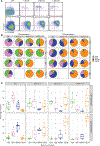Antitumor Activity Associated with Prolonged Persistence of Adoptively Transferred NY-ESO-1 c259T Cells in Synovial Sarcoma
- PMID: 29891538
- PMCID: PMC8092079
- DOI: 10.1158/2159-8290.CD-17-1417
Antitumor Activity Associated with Prolonged Persistence of Adoptively Transferred NY-ESO-1 c259T Cells in Synovial Sarcoma
Abstract
We evaluated the safety and activity of autologous T cells expressing NY-ESO-1c259, an affinity-enhanced T-cell receptor (TCR) recognizing an HLA-A2-restricted NY-ESO-1/LAGE1a-derived peptide, in patients with metastatic synovial sarcoma (NY-ESO-1c259T cells). Confirmed antitumor responses occurred in 50% of patients (6/12) and were characterized by tumor shrinkage over several months. Circulating NY-ESO-1c259T cells were present postinfusion in all patients and persisted for at least 6 months in all responders. Most of the infused NY-ESO-1c259T cells exhibited an effector memory phenotype following ex vivo expansion, but the persisting pools comprised largely central memory and stem-cell memory subsets, which remained polyfunctional and showed no evidence of T-cell exhaustion despite persistent tumor burdens. Next-generation sequencing of endogenous TCRs in CD8+ NY-ESO-1c259T cells revealed clonal diversity without contraction over time. These data suggest that regenerative pools of NY-ESO-1c259T cells produced a continuing supply of effector cells to mediate sustained, clinically meaningful antitumor effects.Significance: Metastatic synovial sarcoma is incurable with standard therapy. We employed engineered T cells targeting NY-ESO-1, and the data suggest that robust, self-regenerating pools of CD8+ NY-ESO-1c259T cells produce a continuing supply of effector cells over several months that mediate clinically meaningful antitumor effects despite prolonged exposure to antigen. Cancer Discov; 8(8); 944-57. ©2018 AACR.See related commentary by Keung and Tawbi, p. 914This article is highlighted in the In This Issue feature, p. 899.
Trial registration: ClinicalTrials.gov NCT01343043.
©2018 American Association for Cancer Research.
Conflict of interest statement
Disclosure of Potential Conflicts of Interest
Sandra P. D’Angelo reports receiving commercial research support from Adaptimmune. J. Glod is a consultant/advisory board member for GSK. S.A. Grupp reports receiving commercial research support from Adaptimmune and is a consultant/advisory board member for the same. W.D. Tap is a consultant/advisory board member for Adaptimmune
Figures





Comment in
-
Engineered T Cells in Synovial Sarcoma: Persistence Pays Off!Cancer Discov. 2018 Aug;8(8):914-917. doi: 10.1158/2159-8290.CD-18-0618. Cancer Discov. 2018. PMID: 30076141
References
-
- Brennan MF, Antonescu CR, Maki RG. Management of soft tissue sarcoma. New York, NY: Springer; 2012.
-
- Powles T, Eder JP, Fine GD, Braiteh FS, Loriot Y, Cruz C, et al. MPDL3280A (anti-PD-L1) treatment leads to clinical activity in metastatic bladder cancer. Nature 2014;515:558–62. - PubMed
Publication types
MeSH terms
Substances
Associated data
Grants and funding
LinkOut - more resources
Full Text Sources
Other Literature Sources
Medical
Molecular Biology Databases
Research Materials

